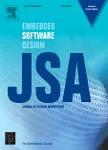版权所有:内蒙古大学图书馆 技术提供:维普资讯• 智图
内蒙古自治区呼和浩特市赛罕区大学西街235号 邮编: 010021

作者机构:TU Eindhoven Dept Math & Comp Sci Eindhoven Netherlands Intel BV Eindhoven Netherlands
出 版 物:《JOURNAL OF SYSTEMS ARCHITECTURE》 (系统结构杂志)
年 卷 期:2016年第65卷
页 面:15-29页
核心收录:
学科分类:08[工学] 0835[工学-软件工程] 0812[工学-计算机科学与技术(可授工学、理学学位)]
基 金:RVO (an agency of the Dutch Ministry of Economic Affairs) as part of the EU-REKA/ITEA2/MANY project [ITEA121002]
主 题:Dataflow graph Runtime scheduling Timing analysis
摘 要:Constituent tasks of modern day Embedded Streaming Applications (ESAs), such as engine control systems, multimedia and software defined radios often exhibit execution behaviors that do not conform to conventional task models. ESAs consist of iterative, pipelined sequences of tasks that are conditioned by intra- and inter-iteration dependencies, and often have strict throughput and latency requirements. We model ESAs as dataflow graphs, where actors represent computational units, and directed edges represent communication channels between actors. Due to practical constraints like cost-effectiveness, power consumption and chip-area, multiple ESAs are run on a shared (multi-processor) platform. Thus rigorous timing analysis is required to verify whether individual ESAs meet their respective timing requirements. We look at response modeling, a compositional timing analysis approach wherein the local worst-case influence of runtime scheduling is represented within the constructs provided in dataflow. These local representations (called response models) can be composed together to construct a global understanding of an ESA s worst-case execution which is then used to verify whether its real-time requirements are met. This paper proposes a generic response modeling technique for runtime scheduling of ESAs. We focus on preemptive Fixed Priority Scheduling (FPS) but also demonstrate that we can apply our technique to a wide range of runtime schedulers. In our experiments, we present academic and industrial case-studies that highlight the effectiveness of our approach in the timing analysis of ESAs with unconventional execution behavior. (C) 2016 Elsevier B.V. All rights reserved.